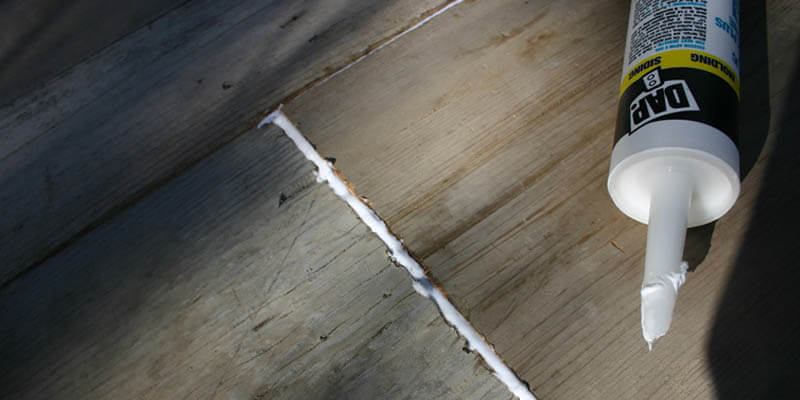Whenever it comes to sealing any leakage, caulking is the option. Caulking not only prevents leaks but also repairs cracks, gaps, and joints less than 1/4 inch wide. Houses need caulking to keep water out and to keep their roofs in good condition.
Caulking by yourself sounds like a simple enough task for many homeowners. It’s a fast process, but you’ll have to start from scratch and try again if you make a mistake. And anyone who spends time, effort, and money doing the same thing over and over again will find it boring and worthless.
Though the process of caulking is quite easy, when it comes to newbies, inexperienced, and novices, making the caulk sustainable is not that easy because they usually make a bunch of mistakes while caulking on a surface.
I believe you already know the basic fundamentals of caulking but may still make mistakes during caulking. So, sorting them out and solving them is also important. In this article, our The Swift Home expert will try to figure out all those common caulking problems and their solutions.
What Causes Caulking to Fail?
Mostly, caulk fails because of the lack of stickiness. The caulk failed to stick properly on the surface that cracked or peeled after a few days.
Caulk can fail if the trim pieces, like crown moldings, door and window frames, and baseboards, are not securely attached to the wall and ceiling surfaces.
If you push on a piece of trim and it moves, then it needs to be more securely attached. Caulk is also affected by temperature, moisture, and vibrations.
Occasionally, caulk only bridges the surface of a crack if it is too tight or narrow to get into. Because the caulk does not reach the crack, it will split even at low temperatures and high humidity.
To prevent caulking failure, removing extra caulk is a common practice. In such a case, use a damp-wipe before applying caulk to the interior trim. Because a bead that is too thin will easily crack and split if too much is removed during the cleaning process.
In the case of exterior caulk, a thicker layer of caulk should be applied than in the case of interior caulk in order to withstand more severe weather conditions.
Common Caulking Mistakes – That People Usually Make
When it comes to caulking, making the following mistakes is very common. Have a look:
1. Selecting the Best Caulk
Most homeowners are not used to dealing with caulk until the old caulk goes away. Caulk serves a variety of purposes in protecting your house and the materials it is constructed from.
Transitions between two or more neighboring materials can be made easier with the help of a flexible material. As a sealant, caulk is best suited for cracks and seams less than 1/2-inch-wide since it reduces air and water movement.
It’s not as simple as picking up a tube of caulk and applying it as needed. There are a variety of caulks and ways of application that can be used in a variety of scenarios. Choosing inappropriate caulk for particular places can create a mess. There are four types of caulk that people use a lot.
- Silicone Caulk

If you are interested in using silicone caulk around your bathtub, then it can be applied to a wide variety of surfaces, and the plus point is that silicone caulk is waterproof. This sort of caulk is tough to work with since it is flexible, though it is hard to remove.
- Latex Caulk

Water-based latex caulk, often known as acrylic or vinyl caulk, is the most user-friendly. They are also the cheapest, but not as long-lasting as other options. Latex caulks don’t contain volatile solvents and come in a variety of colors.
- Rubber Caulk

Water-repellent rubber caulks are also available on the market, but the solvents in these caulks are extremely hard and should not be inhaled. As a result, rubber caulks are ideal for outdoor applications. Rubber caulks shrink as they cure, and this quality makes them difficult to work with.
- Polyurethane Caulk
Finally, polyurethane sealants are long-lasting, but they are quite expensive. If you can afford the price tag, this caulk should be used sparingly and only when weather resistance, strength, and durability are present.

Using caulk can be tricky, so make sure you have the correct tool for the job before you begin. The caulking process can be easier with a caulking gun because it provides a better caulking tube tip.
2. Lack of Preparation
Sometimes people start caulking on a surface without any preparation, such as cleaning the surface or removing old caulk. As a result, the caulk becomes cracked and dirty after a few days.
3. Getting Rid of Old Caulk

If you don’t remove the old caulk first, you can’t make a waterproof seal around the surface. Every expert homeowner says that the old caulk won’t stick to the new caulk. The best way to get rid of caulk is to use a chemical caulk remover along with tools you can use by hand.
4. A Mistake in the Re-Caulking Process
When it comes to re-caulking, there are a lot of ways to make a mistake. You need years of experience and the right caulk to get the perfect bead of caulking. If you don’t use caulk correctly, bugs and moisture can get into your home.
This can cause mold to grow, which is bad for your health. Also, it can cause your utility costs to go up.
Many homeowners think it’s worth the extra money to hire a professional caulker to do their re-caulking work because it gives them satisfaction.
5. Ignoring the Drying Procedure
If water gets into the caulk before it has had enough time to cure, it won’t work very well. If it takes longer than expected to dry and cure, you might not get the tight seal you wanted.
In such a case, the caulk needs to peel off, and the project will have to start over.
Most people make mistakes in this part. They hurry through the drying procedure of the caulk and do not give enough time to dry the caulk.
How Do You Fix Caulking Mistakes?

If the caulking process requires mistakes, then they have solutions too. And here are some basic solutions to caulking mistakes.
A Perfectly Cut Caulk Tube

No matter which caulk you are using and how long the caulking bead is, cut all caulk nozzles at a 45-degree angle to put the caulk in a thin layer.
Avoiding Applying Low-Quality Caulk
Homeowners frequently claim that their caulking technique is unsatisfactory because the previous painters used poor sealant, damaging the paint years before it would have naturally been required for replacement.
Water could enter the paint and destroy the surface of the caulk if it fails to seal the margins properly.
When a low-brand caulk is used, it may also cause issues. Even a high-quality kitchen sealant cannot handle the joints and beams’ expansion and contraction as a result of weather conditions, causing it to fail.
After investing a significant amount of money in high-quality paint, the last thing you want is for it to be ruined by water damage years earlier than it should have been due to poor caulking that might have been prevented with better materials.
So, before purchasing any caulk, simply read the reviews to avoid caulk failure.
Proper Usage of Caulking Equipment

Caulking equipments are essential for professional caulking. There are different types of caulking tools available on the market, such as utility knives, wire brushes, painter’s tape, caulking guns, caulking finishing tools, etc.
To use these types of tools, pay some attention to their usage. In the case of using silicone and polyurethane caulks, use a caulking gun, because these two types of caulks are pretty messy.
On the other hand, use a utility knife to remove the old caulk. When you just want to make your caulking line straight, use painter’s tape. Use a wire brush to clean the dust and dirt off the caulk. And lastly, to smoothen the caulk, use the caulk finishing tools properly, but alternatively, you can use a fingertip.
Final Tips
To avoid caulking mistakes, a homeowner needs to learn how to caulk perfectly, or alternatively, he can hire an expert as an alternative. If you are a homeowner who loves to caulk by yourself, just go through this blog to make your caulking procedure a bit more professional.
Want to Learn More:
Hello! this is John Cox. If I’m not wrong, you love Home. Right? And you already met one of them who’ve been in this field since 2005 and still go on. According to my interest, I’ve started this blog to share my thoughts about Home sectors, and you’ll love it.


